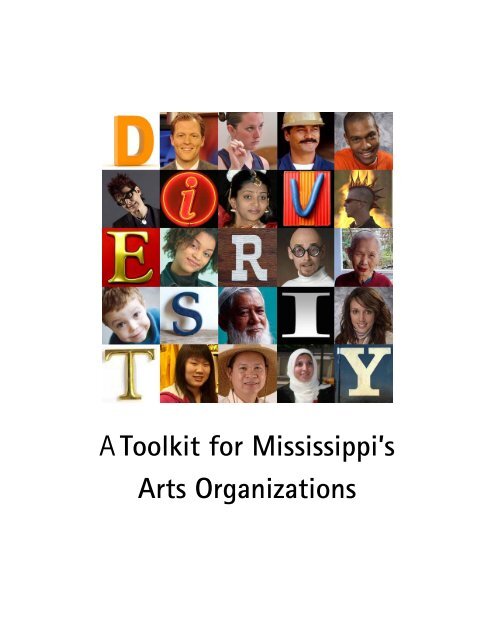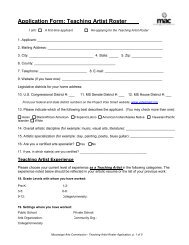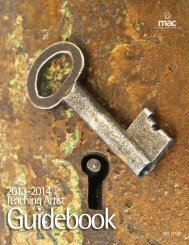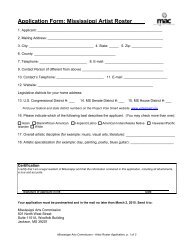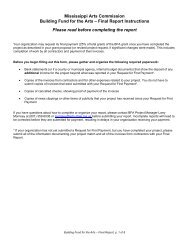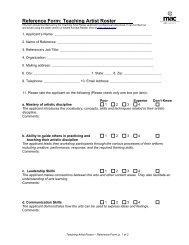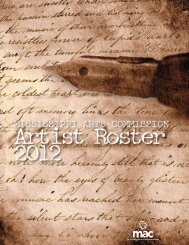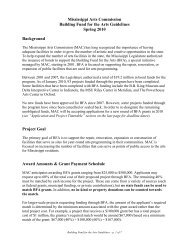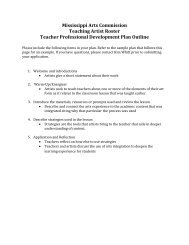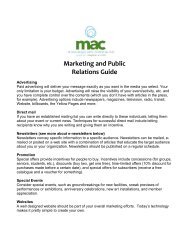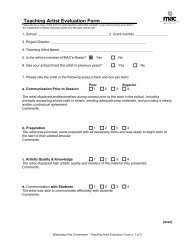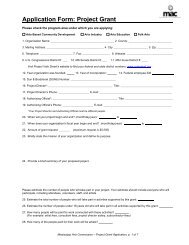AToolkit for Mississippi's Arts Organizations - Mississippi Arts ...
AToolkit for Mississippi's Arts Organizations - Mississippi Arts ...
AToolkit for Mississippi's Arts Organizations - Mississippi Arts ...
You also want an ePaper? Increase the reach of your titles
YUMPU automatically turns print PDFs into web optimized ePapers that Google loves.
A Toolkit <strong>for</strong> <strong>Mississippi</strong>’s<strong>Arts</strong> <strong>Organizations</strong>
The <strong>Mississippi</strong> <strong>Arts</strong> Commission (MAC) serves as the statewidevoice <strong>for</strong> the arts. The agency strives to increase the public valueof creativity, working to build our state’s creative economy.The objective of this manual is to offer basic in<strong>for</strong>mation on theissues surrounding diversity, as well as to provide strategies <strong>for</strong>arts leaders who want to increase the diversity of theirorganization and its offerings. MAC hopes to stimulate the work ofarts and cultural organizations so that we become a true mirrorimage of our communities.The topics included are not meant to be exhaustive. You areencouraged to adapt this in<strong>for</strong>mation based on realistic strategiesand timelines that will work best <strong>for</strong> your community.
IntroductionMAC’s mission statement is: to be a catalyst <strong>for</strong> the arts and creativity in <strong>Mississippi</strong>.Government support, along with the private sector: provides <strong>for</strong> the inclusion of all citizens in diverse arts experiences; ties arts to economic development through partnerships and collaborations; offers credibility and insists on accountability; ensures openness of decision making; and provides leadership in cultural policiesMAC encourages the organizations funded by its grants and services to seek inclusionand participation from the communities and neighborhoods served around the region ofthe state.Diversity is defined as the sum of the ways that people are both alike and different. Thedimensions of diversity include race, ethnicity, gender, sexual orientation, language,culture, religion, mental and physical ability, class, and immigration status. The culturalorganizations in our state should be a reflection of that diversity. While diversity itself isnot a valueladen term, the way that people react to it is driven by their own values,attitudes, and beliefs. <strong>Arts</strong> and cultural experiences that include the diversity of acommunity help to grow and strengthen it. MAC wants to support diversity incommunities around the state. We understand that building diversity is a large task andno one organization can be tasked with changing the world. It is with this understandingthat we encourage organizations to begin having conversations that will lead tostrategies to engage the different groups in their community.It is also important <strong>for</strong> arts organizations to educate themselves about, and connectwith, the diverse beliefs and values of the public. Cultural institutions should recognizeand respect the diverse beliefs found in their community. But in order to do that,strategies <strong>for</strong> building diversity must be in place.<strong>Arts</strong> organization staff and board members should examine their own attitudes, realizingthat people may think differently. Then they should look at the demographics of theircommunity and consider who is not being served by their organization.
MAC defines diversity in arts organizations as: Presenting per<strong>for</strong>mances, exhibitions, arts education programs, or other servicesto the public as its primary function with a desire to reach all segments of thepopulation. Creating programs that are inclusive by involving the community in planning,implementation and evaluation of its programs. Involving planners and participants that reflect the community’s demographics. Providing access to the arts <strong>for</strong> the state’s residents with emphasis onmaintaining and expanding programs and services. Finding board members who reflect the community and contribute to theorganization.Anecdotal In<strong>for</strong>mation: Theatre groups such as the Natchez Little Theatre and Theatre Plus in PortGibson, as well as others around the state are implementing “color blind” castingpractices (casting a role without considering the actor’s ethnicity.) Choirs and choral groups are singing ‘hallelujah’ as we listen to their harmoniesand see faces that represent the people living in their communities.· The Lauren Rogers Museum of Art, <strong>Mississippi</strong> Museum of Art, Ohr O’KeefeMuseum of Art, Meridian Museum of Art, Walter Anderson Museum of Art andothers are offering diverse programming that encourages the community to getinvolved because of the intentional variety of programming Museums are employing senior citizens and persons living with disabilities asparttime and fulltime employees and job duties have been adapted toaccommodate their needs. Symphony orchestras collaborate with schools <strong>for</strong> student centeredper<strong>for</strong>mances. <strong>Arts</strong> organizations offer reduced price tickets to specific groups as part of theiroutreach. Statistics gathered in a 2010 study conducted by MAC shows that organizationsfunded by MAC who have spent at least 35 years working on diversity haveachieved a measure of success:
o Children with both learning and physical disabilities have participated inBallet <strong>Mississippi</strong> classes.o The Craftsmen’s Guild offers summer camps <strong>for</strong> children/youth withdisabilities free of charge so that children with special needs receiveart/craft classes taught by master craftsmen, some of whom havedisabilities themselves.o The DeSoto County <strong>Arts</strong> Council hosted an art <strong>for</strong> autism program inpartnership with a local hospital and foundation.o The Lauren Rogers Museum of Art organizes a Very Special <strong>Arts</strong> Festivaleach year <strong>for</strong> school children with disabilities from a sixcounty area.
Diversity and Cultural Proficiency Assessment ToolDoes your organization reflect the community it serves?Communities are multifaceted and ever changing. An organization should periodicallyask itself how they can be sure that they are delivering the highest quality and mostculturally proficient services to the community.The following is a list of assessments that can be adapted to meet the needs andcapacities of your organization. It is a starting point <strong>for</strong> evaluating the diversity andcultural proficiency of your organization and will help in identifying activities andpractices that are in place or need to be implemented. Your organization is encouragedto adapt this in<strong>for</strong>mation based on strategies and timelines that are realistic <strong>for</strong> you.Community Diversity Do you monitor the ongoing demographic changes occurring in your community(this is something to consider doing at least every three years)? Do you actively use this data <strong>for</strong> strategic and outreach planning? Have you identified community organizations, schools, churches, businesses andpublications that serve racial and ethnic minorities <strong>for</strong> outreach and educationalpurposes? Do you have a strategy <strong>for</strong> partnerships with others that includes the communityserved? Do the organizations you partner with reflect the diversity of the community? Have you met with community leaders to gauge their perceptions of yourorganization? Have you sought their advice on how you can better serve them? Have you conducted focus groups and surveys within the past three years inyour community to measure the public’s perception of your organization as itrelates to diversity and cultural issues? How do you act on this in<strong>for</strong>mation? Are the individuals who represent your organization reflective of thedemographics of the community? Does your organization have a strategy to ensure that you are utilizingbusinesses in the minority community <strong>for</strong> products and services that youpurchase?
Are your public communications (such as reports, advertisements, and websites), accessible to and reflective of your community?Cultural Diversity Do you regularly monitor the racial and ethnic diversity of the people you serve?· Do your internal and external communications include your commitment toproviding culturally proficient services (i.e., the ability to interact with people ofdifferent cultures and socioeconomic background)? Do your evaluations and surveys take into account the diversity of your patrons? Do you compare patron satisfaction ratings among diverse groups and act on thein<strong>for</strong>mation? Has your staff and volunteers received special training in diversity issues? Has your organization identified qualified people who could help your staffcommunicate with the public from a wide variety of nationalities? Are your written communications available in languages that reflect the ethnicand cultural fabric of your community? Are they offered in alternate <strong>for</strong>mats suchas large print <strong>for</strong> the visually impaired? Do your services include complementary and alternative services in planning <strong>for</strong>inclusion (i.e., large print, sign language interpretation, or audio description)?Work<strong>for</strong>ce Diversity Do your recruitment ef<strong>for</strong>ts include strategies to reach out to the racial and ethnicminorities in your community? Do the people who recruit new staff <strong>for</strong> your organization reflect the diversity thatyou need? Do your policies about time off and holidays and religious observances take intoaccount the diversity of your work<strong>for</strong>ce? Do you acknowledge and honor diversity in your employee communications,awards programs and other internal celebrations? Have you made diversity awareness and sensitivity training available to youremployees? Do you have a mechanism in place to look at employee turnover rates <strong>for</strong>variances according to diverse groups?
Do you ensure that changes in job design, work<strong>for</strong>ce size, hours and otherchanges do not affect diverse groups disproportionately?Leadership Team Diversity Is there a boardapproved policy encouraging diversity across the organization,including the board? Is diversity a part of the board’s regular discussions? Is this policy reflected in your mission and values statement? Is it visible ondocuments seen by your employees and the public? Does your strategic plan emphasize the importance of diversity at all levels ofyour work<strong>for</strong>ce? Has your board set goals <strong>for</strong> creating or building services that eliminatedisparities to underserved groups? Have you designated a member of your board or staff who is responsible <strong>for</strong>implementing your diversity strategy? Have sufficient funds been allocated to achieve your diversity goals? Is diversity awareness and cultural proficiency training mandatory <strong>for</strong> all staff? Have you made diversity awareness part of your management and board retreatagendas? Does your organization have a mentoring program in place to help develop yourbest talent, regardless of gender, race or ethnicity? Do you encourage employees to further their education? Do you have a succession or advancement plan <strong>for</strong> your management team thatis linked to your overall diversity goals? Do you require search firms who work <strong>for</strong> your organization to present a mix ofcandidates reflecting your community’s diversity?
Strategies <strong>for</strong> Building DiversityUnderstanding culture is important so that we will know how to interact with individualsfrom cultures that are different from ours.∙∙∙∙∙Valuing Diversity: You should accept and respect differences, such as differentcultural backgrounds, values and customs, as well as different ways ofcommunicating.Cultural SelfAwareness: Culture is the sum total of an individual's experiences,knowledge, skills, beliefs, values, and interests. It shapes who we are and howwe fit into community and society. Reflect on your own racial identity and how ithas shaped your life experiences. Personal inquiry is a necessary prerequisite tofacilitating inquiry among others.Dynamics of Difference: Foster a sense of safety around conversations aboutrace by encouraging participants to take responsibility <strong>for</strong> their own learning andinteractions, to respect each other, to avoid blame and snap judgments, and toallow <strong>for</strong> mistakes.Institutionalize Cultural Knowledge <strong>for</strong> Diversity: Culturally competentindividuals and the institutions they work in can take steps to institutionalizecultural knowledge so they can adapt to diversity and better serve diversepopulations. Learn within the context of culture. Asset mapping is one way to seethe benefits of the community on a culture and the culture on its community.Communicate High Expectations: Develop researchbased training on theory,culture, diversity, social status, and policy (see Resource section at the end ofthis document). Create an advisory task <strong>for</strong>ce that represents the community.∙∙Market with Diversity in Mind: Events and services should be designed toachieve the goals and objectives found in the long range strategic plan <strong>for</strong>outreach and marketing to specific audiences. Create a meaningful blueprint thatincludes sustained inquiry, examination of challenges and a plan. Formstrategies to foster justice with an inclusive mindset: who is being left out?Expand Ef<strong>for</strong>ts to Increase Public Participation in Programming: Eventsand services should be driven by evaluation. Understanding your audienceand what they want to experience and learn is a balancing act when it comes tobuilding audience loyalty centered on the mission and vision of an organization.An arts or cultural organization must take stock be<strong>for</strong>e coming up withapproaches on how to sell an artistic product.
∙∙∙Strive to Provide <strong>Arts</strong>, Heritage and Cultural Education That is Relevant:<strong>Arts</strong> education opportunities should be available and offered to all citizens andthe challenge is to provide these services in a way that takes into considerationwhether the audience is interested in what is being offered. Programming shouldbe respectful and reflective of the community. Research the racial compositionand cultural languages represented in the community. Design education activitiesthat reach the broad spectrum of learners and audiences.Create an Atmosphere of Equal Opportunity: Encourage policies to achieveequal hiring, salaries, and promotion standards. Seek to create an atmosphere ofmoral and mutual respect, appreciation and appropriate considerations given invarious situations with a conscientious regard <strong>for</strong> one’s fellowman/woman/person. Everyone has a right to the opportunity to participate,volunteer, seek employment, serve and be served. Maintaining understandingand level respect can be achieved, but it takes having a diversity and inclusionplan in place be<strong>for</strong>e it can intentionally happen.Create Programs That Are Accessible: Cultural organizations that receivefederal funds must make programs, services and activities accessible, includingemployment opportunities. When developing an accessibility plan, anorganization should consider:o Appoint an accessibility coordinatoro Review the ways they interact with constituentso Review a checklist on the accessibility of buildings and groundso Ensure that there is a plan <strong>for</strong> assuring accessibility of public meetingso Design print and webbased materials <strong>for</strong> legibility, ease ofcomprehension, as well as accessibility by people with hearing, mobilityand visual disabilitieso Accessibility of other communication systemso Programming that is respectful and reflective of the communityo Create partnerships that promote inclusion and access
Action StepsThe following are a suggested series of actions that an organization can utilize inbeginning a dialogue on diversity and cultural proficiency:∙∙∙∙∙∙Direct your management team to complete the assessment in the previoussection. Conduct a meeting to compare your team’s responses.Ask your planning and community relations leaders to prepare a presentation <strong>for</strong>your organization’s administration on the demographics of your community andyour patrons. Discuss the results in light of the assessment results.Meet in<strong>for</strong>mally with leaders of racial and ethnic minority groups in yourcommunity <strong>for</strong> a candid conversation about their concerns, perceptions of yourorganization and the services you provide.Review the composition of your work<strong>for</strong>ce in light of your community’sdemographics to determine how well your organization reflects your community’sdiversity.Meet in<strong>for</strong>mally with minority employees <strong>for</strong> a candid conversation about theirobservations and concerns about their workplace and its environment.Put together an internal task <strong>for</strong>ce to review the results of Actions 15 andrecommend next steps. Present these to your board <strong>for</strong> consideration.∙Put together a longterm strategy to create a more diverse organization at alllevels that delivers more culturally proficient programming and services.
ResourcesThere are a number of books and free resources online that arts and cultural institutionscan utilize when developing a diversity strategy:Online ResourcesA New Framework <strong>for</strong> Building Participation in the <strong>Arts</strong>, by Kevin F. McCarthy,Kimberly J. Jinnett, www.rand.org/pubs/monograph_reports/MR1323.html<strong>Arts</strong> <strong>for</strong> All: Connecting to New Audienceshttp://www.wallacefoundation.org/knowledgecenter/audiencedevelopment<strong>for</strong>thearts/strategies<strong>for</strong>expandingaudiences/Pages/<strong>Arts</strong><strong>for</strong>AllConnectingNewAudiences.aspx<strong>Arts</strong> Participation 2008: National Endowment <strong>for</strong> the <strong>Arts</strong> Survey of PublicParticipation in the <strong>Arts</strong>, http://www.nea.gov/news/news09/SPPAhighlights.htmlCultivating Demand <strong>for</strong> the <strong>Arts</strong>: <strong>Arts</strong> Learning, <strong>Arts</strong> Engagement, and State <strong>Arts</strong>Policyhttp://www.wallacefoundation.org/knowledgecenter/audiencedevelopment<strong>for</strong>thearts/Pages/default.aspxThe Diversity of Cultural Participation: Findings from a National Survey//www.wallacefoundation.org/knowledgecenter/audiencedevelopment<strong>for</strong>thearts/audiencesurveys/Pages/TheDiversityofCulturalParticipation.aspxEngaging Audienceshttp://www.wallacefoundation.org/knowledgecenter/audiencedevelopment<strong>for</strong>thearts/strategies<strong>for</strong>expandingaudiences/Pages/EngagingAudiences.aspx
Book ResourcesChampions of Change: The Impact of the <strong>Arts</strong> on Learning, Edited by Fiske,Edward B., <strong>Arts</strong> Education Partnership, 1999.Cultural Collaborations: Building Partnerships <strong>for</strong> <strong>Arts</strong> Participation, By Ostrower,Francie, Urban Institute, 2003.Invitation to the Party: Building Bridges to the <strong>Arts</strong>, Culture and Community,By WalkerKuhne, Donna, Theatre Communication Group, 2005.Take Part: A Look at Trends in Leisure and Cultural Participation among<strong>Mississippi</strong> Residents, A summary of research <strong>for</strong> the <strong>Mississippi</strong> <strong>Arts</strong> Commission byWestern States <strong>Arts</strong> Federation, 2005.Engaging AudiencesThe Diversity of Cultural Participation: Findings from the National Surveyhttp://www.wallacefoundation.org/knowledgecenter/audiencedevelopment<strong>for</strong>thearts/audiencesurveys/Pages/TheDiversityofCulturalParticipation.aspxTake Part: A Look at Trends in Leisure and Cultural Participation among<strong>Mississippi</strong> Residents, A summary of research <strong>for</strong> the <strong>Mississippi</strong> <strong>Arts</strong> Commission byWestern States <strong>Arts</strong> Federation, 2005,http://www.per<strong>for</strong>mingartsregister.com/pdfs/TakePart_MS_Study.pdf
501 North West StreetSuite 1101AWoolfolk BuildingJackson, <strong>Mississippi</strong> 39201601/359-6030www.arts.ms.gov


